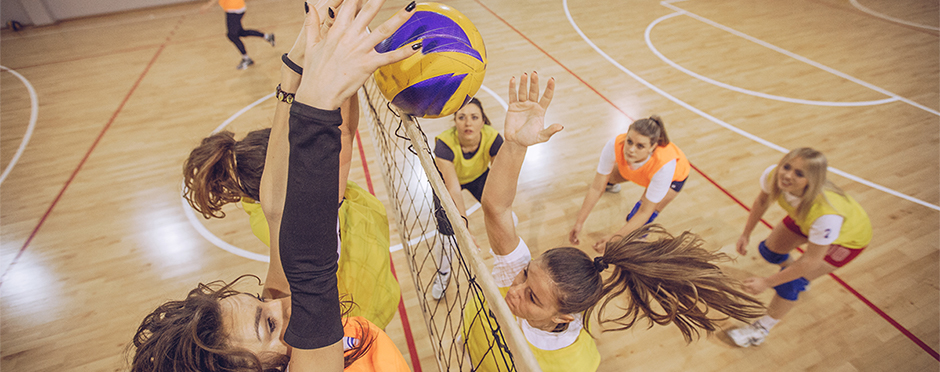
4 Common Volleyball Injuries and Treatment Options
1 CommentVolleyball is a fun sport for kids and adults and can be played both indoors and outdoors. However, like most sports, injuries can occur. Read below to learn about some of the most common injuries for the sport and ways to treat them.
Ankle Sprains
- How injury may occur: Ankle sprains most commonly occur at the net when one player lands on another player’s foot.
- Treatment: RICE: rest, ice, compression, elevation. A brace may be required upon initial return to sport.
- Tip: include balance training in rehabilitation such as standing on less stable surfaces, balance board, or BOSU® to challenge the smaller muscles and ligaments of the ankle to decrease risk of re-injury
Jumper’s Knee (patellar tendinitis)
- How injury may occur: Due to the amount of repetitive jumping and landing in volleyball, pain can begin to occur below the kneecap. This is an injury that typically occurs over time instead of from one traumatic event.
- Treatment: Rest, stretching and strengthening of the legs are a few of the ways to treat patellar tendinitis. Areas of focus include stretching and strengthening of the quads, hamstrings, and glute muscles.
- Tip: Be aware of the surface you are playing on, concrete has no shock absorbency. Also vary your activities to avoid too much impact. Swimming and cycling are good alternatives to running and jumping.
Shoulder Instability
- How injury may occur: The repetitive overhead motions of serving, spiking and blocking used in volleyball can lead to shoulder instability in young athletes. Due to the extreme positions of the arm to perform these movements, the muscles and ligaments can become stressed. Athletes may feel excessive movement in their shoulder or it can feel unstable. Structures inside the joint, such as the labrum, can also become impinged with these extra movements, resulting in pain.
- Treatment: Rest and physical therapy can help with instability. Therapy will focus on strengthening muscles surrounding the shoulder, including the muscles forming the rotator cuff. In extreme instances of instability (repetitive shoulder dislocations), surgery may be indicated.
- Tip: Make sure strengthening exercises include overhead strengthening, as overhead movements are common in volleyball players. Examples include overhead body blade exercises, overhead ball taps on wall, and overhead wall walks with theraband.
Finger Injuries
- How injury may occur: Trauma to fingers is common in blocking or setting in volleyball, as well as encounters with the net or other players. Usually the injury is a sprain, tendon tear or fracture.
- Treatment: Treatment for finger injuries depends on the severity of the injury. Most sprains do well with rest, ice and buddy taping. For more severe injuries, casting or surgery may be necessary.
- Tip: X-rays are recommended for finger injuries to check for fracture and prevent long-term deformity and dysfunction.
If you feel you have suffered an injury in volleyball, contact your closest Athletico clinic to schedule a free assessment.
The Athletico blog is an educational resource written by Athletico employees. Athletico bloggers are licensed professionals who abide by the code of ethics outlined by their respective professional associations. The content published in blog posts represents the opinion of the individual author based on their expertise and experience. The content provided in this blog is for informational purposes only, does not constitute medical advice and should not be relied on for making personal health decisions.

1 Comment
Rhianna Hawk
I think I’m experiencing some tendinitis that has been getting worse; the pain in my legs, just below the knee as you described, gets more intense with every game. My teammates have told me to sit out a few games to recover, and it’s good to know that rest does help with that sort of injury. I’ll be sure to see a physical therapist to see what sort of stretches they recommend to help get the strength back, as you suggest.